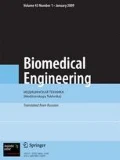A pre-production model of the first domestic wearable artificial kidney Renart-PD and the results of its trials are presented. The trials involved regeneration of model solutions and biological fluids (spent solution for peritoneal dialysis). It was shown that the regeneration procedure could continue up to 24 h with a mean mass rate of metabolite removal comparable to that provided by healthy kidneys.
Similar content being viewed by others
References
Breakthrough Devices Program, US Food & Drug Administration, https://www.fda.gov/regulatory-information/search-fda-guidance-documents/breakthrough-devices-program (accessed January 23, 2020).
Htay, H., Gow, S., Jayaballa, M., Oei, E., Jamaluddin, S. N. H., Lim, J., and Foo, M., “Evaluation of safety of automated wearable artificial kidney (AWAK) device in peritoneal dialysis patients,” Kidney Int. Rep., 4, No. 7, S183 (2019).
Gerritsen, K., “WEAKID – Clinical validation of miniature wearable dialysis machine-H2020,” Impact, 2018, No. 3, 55-57 (2018).
Putrya, B. M., Bazaev, N. A., and Zhilo, N. M., “Electrochemical method of dialysate regeneration,” in: Proc. 2019 Ural Symposium on Biomedical Engineering, Radioelectronics and Information Technology USBEREIT 2019 (2019), pp. 70-73.
Wester, M., Simonis, F., Lachkar, N., Wodzig, W. K., Meuwissen, F. J., Kooman, J. P., Boer, W. H., Joles, J. A., and Gerritsen, K. G., “Removal of urea in a wearable dialysis device: A reappraisal of electro-oxidation,” Artif. Org., 38, No. 12, 998-1006 (2014).
Bazaev, N., Zhilo, N., and Selishchev, S., “The analysis of the dialysate composition after fermentation and electrochemically mediated sorbent regeneration,” Int. J. Art. Org., 41, No. 9, 529-530 (2018).
Cheah, W.-K., Ishikawa, K., Othman, R., and Yeoh, F.-Y., “Nanoporous biomaterials for uremic toxin adsorption in artificial kidney systems: A review,” J. Biomed. Mat. Res. Part B: Appl. Biomat., 105, No. 5, 1232-1240 (2017).
Urbańczyk, E., Sowa, M., and Simka, W., “Urea removal from aqueous solutions – A review,” J. Appl. Electrochem., 46, No. 10, 1011-1029 (2016).
Kolesnik, A. A., Bazaev, N. A., and Streltsov, E. V., “Development and evaluation of the efficiency of an adaptive system for control transmembrane pressure wearable artificial kidney,” Int. J. Art. Org., 42, No. 8, 427 (2019).
Streltsov, E. V. and Bazaev, N. A., Software for Operating an Experimental Model of Wearable Artificial Kidney from PC in Service Mode: State Software Certificate No. 2016619871 (2016).
Author information
Authors and Affiliations
Corresponding author
Additional information
Translated from Meditsinskaya Tekhnika, Vol. 54, No. 2, Mar.-Apr., 2020, pp. 4-6.
Rights and permissions
About this article
Cite this article
Bazaev, N.A. Wearable Artificial Kidney Renart-PD. Biomed Eng 54, 83–87 (2020). https://doi.org/10.1007/s10527-020-09979-1
Received:
Published:
Issue Date:
DOI: https://doi.org/10.1007/s10527-020-09979-1



